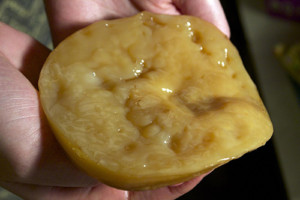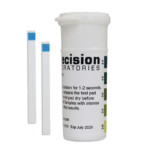A while back, Cultures for Health did a Tech Talk blog post for us about how kombucha is made. We asked them to give us some insight on this popular drink because in recent years, our pH 2.8-4.4 test strips, originally developed for testing homemade wine, have been used to test homemade kombucha as well. We didn’t know much about the topic, but Cultures for Health really helped us understand the basics.
Now, we want to dig a little deeper into the role pH plays in kombucha. We learned from our Tech Talk blog post that the ideal pH of kombucha is 3.0-3.5, when it has a mild vinegar flavor. Below pH 3.0, the kombucha has a strong flavor, like vinegar. With a pH above 3.5, the flavor is not as well developed. So, what else does the pH tell us?
pH & Fermentation
 During kombucha fermentation, much like fermenting beer, yeast and bacteria work together to help complete the process. The word SCOBY actually stands for “symbiotic colony of bacteria and yeast”. Not all SCOBYs contain the same strains of bacteria and yeast, but generally, regardless of the strain used, they produce acetic acid. Acetic acid contributes to the low pH of kombucha.
During kombucha fermentation, much like fermenting beer, yeast and bacteria work together to help complete the process. The word SCOBY actually stands for “symbiotic colony of bacteria and yeast”. Not all SCOBYs contain the same strains of bacteria and yeast, but generally, regardless of the strain used, they produce acetic acid. Acetic acid contributes to the low pH of kombucha.
Vinegar registers at about 2.4 pH and is typically a 4-7% acetic acid solution. Kombucha has less than 1% acetic acid, and again, should have a pH around 3.0-3.5. The lower the pH of kombucha, the more tart it will taste, like vinegar. It may have a sweeter taste if it has a higher pH.
The pH value does not necessarily indicate whether or not the fermentation process is complete. It simply verifies that the kombucha is guarded against microbial contaminants. FDA guidelines state that when the pH of food is 4.6 or below, it does not need further preservatives. Many microorganisms that typically cause food spoilage cannot survive in such a low pH environment.
During fermentation, the pH level will drop to the ideal range in the first few days, but you should really rely on taste to determine when it’s ready and the proper amount of sugar has been converted.
Although solutions high in acetic acid content have a lower pH, acetic acid is not directly related to the pH level. For example, store-bought apple cider vinegar contains approximately 5% acetic acid and has a pH of about 2.9. A homebrew kombucha has less than 1% acetic acid, but might also have a pH of 2.9. Apple cider vinegar is not pleasant to drink, but the kombucha is. Therefore, both testing pH and tasting the kombucha are necessary to distinguish small differences in flavor and determine if the brew is complete.
Testing pH
 You should test the pH of the kombucha at least twice during the brewing process. The first test should be performed initially if adding starter tea to a new batch of tea. The pH should read below 4.6, and if it’s higher, simply continue adding more starter tea or wait an hour and test again. This ensures the fresh batch is acidic enough to fight off contaminants. The pH should drop rapidly in the first few hours of fermentation.
You should test the pH of the kombucha at least twice during the brewing process. The first test should be performed initially if adding starter tea to a new batch of tea. The pH should read below 4.6, and if it’s higher, simply continue adding more starter tea or wait an hour and test again. This ensures the fresh batch is acidic enough to fight off contaminants. The pH should drop rapidly in the first few hours of fermentation.
You’ll want to test the pH again when you think the brewing process is nearly complete. If the pH is in the ideal range, then do your taste test. If the pH is still alkaline, you’ll need a few more days to complete the brewing cycle. Make sure the pH is not below 2.0 before doing your taste test, as this is too acidic for consumption.







Leave A Comment